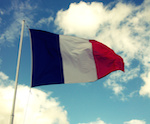If you really want to learn French, you need to know a few French expressions...
Si tu veux vraiment apprendre le Français, il faut connaître quelques expressions Françaises!
You aren’t going to find these in formal language books but equipping yourself with some of these idioms, colloquialisms and tournures de phrases (turns of phrase) will endear you to the French even if your accent betrays you.
Below are a few of the more popular French expressions along with their literal translations (or close to it) and what they mean in English.
1. Ca gaz? (Is it gassing?) – How’s it going?
2. C’est pas terrible (It’s not terrible) – It isn’t that great.
3. Et patati et patata (And blah, blah, blah,) – When someone won’t stop talking.
4. Un froid de canard (A duck’s cold) – It’s extremely cold outside.
5. Faire la grasse matinée (Doing the fat morning) – Sleeping in.
6. Avoir une araignée au plafond (Having a spider on the ceiling) – The ceiling refers to a person’s head and means that he/she is a little odd but that it doesn’t bother anyone.
7. Rentrer bredouille (Returning bredouille) – There’s no real translation for the word bredouille but it means returning empty-handed.
8. Tomber à pic (Falling at the peak) – To arrive at just the right time.
9. Avoir les yeux plus gros que le ventre (Having eyes bigger than the stomach) – This refers to a person whose desire for food was larger than their stomach and they end up overeating or not being able to finish the food on their plate.
10. Mettre la charrue avant les bœufs (Placing the plow before the oxen) – This is similar to the phrase “Putting the cart before the horse” and has the same meaning.
11. Bête comme un chou (Dumb like a cabbage) – Refers to a person who is dumb, similar to the expression “Dumber than a sack of hammers/rocks.”
12. Avoir le feu au derrière (Having fire on your behind) – To be in a hurry.
13. Donner sa langue au chat (To give one’s tongue to the cat) – To give up or to stop guessing.
14. Avoir d’autres chat à fouetter (Having other cats to whip) – Similar to “Having bigger fish to fry” meaning having other things to do.
15. Boire un coup/Prendre un verre (Drink a blow/Take a glass) – To have a drink.
16. Avoir le cafard (Having the cockroach) – Feeling down or depressed.
17. Être dans de beaux draps (Being in nice sheets) – Being in a mess.
18. Dormir sur les deux oreilles (Sleeping on both ears) – Sleeping well, having restful sleep.
19. Vieux/Vieille comme Hérode (Old like Herod) – Referring to King Herod in the Bible, this simply refers to a very elderly person.
20. À fond la caisse (At full throttle) – To go real fast, especially in a vehicle.


Blog submitted by: David at The French Property Network - Cle France.
This blog was originally posted on The French Language Blog pages.